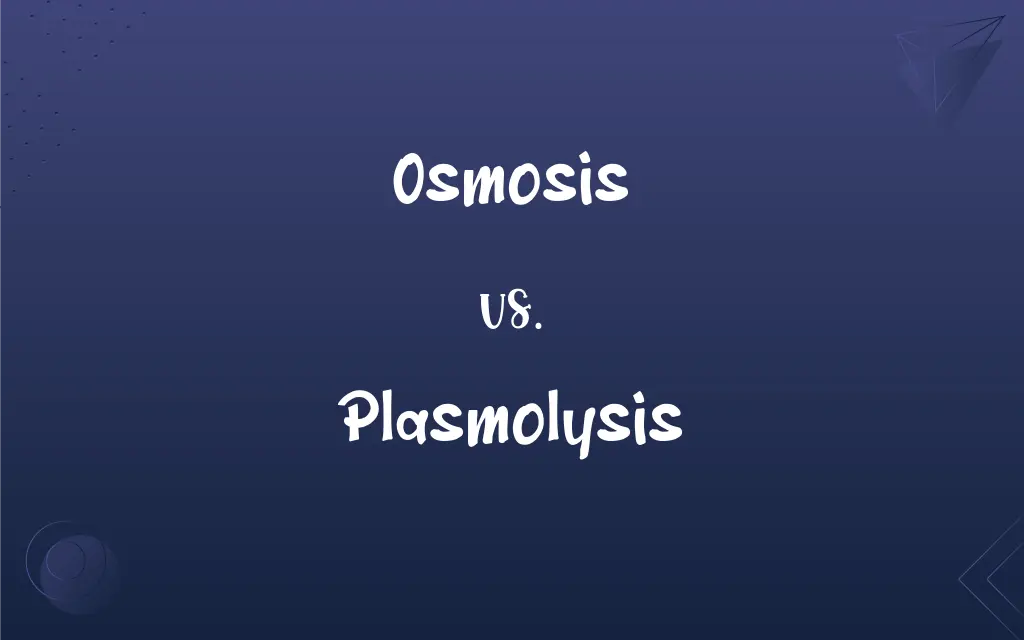Osmosis vs. Plasmolysis: What's the Difference?
Edited by Aimie Carlson || By Janet White || Published on February 4, 2024
Osmosis is the diffusion of water across a semipermeable membrane, while plasmolysis is the process where cells lose water in a hypertonic solution, causing the cell membrane to detach from the cell wall.

Key Differences
Osmosis is a fundamental biological process where water molecules move across a semipermeable membrane towards a higher solute concentration. In contrast, plasmolysis occurs when a plant cell is exposed to a hypertonic solution, leading to the shrinkage of the cell membrane away from the cell wall.
During osmosis, water moves to equalize solute concentrations on both sides of the membrane, a crucial process for maintaining cellular homeostasis. Plasmolysis, however, is a specific reaction of plant cells under extreme osmotic stress, often resulting in cell damage or death.
Osmosis can occur in any cell with a semipermeable membrane and is vital for processes like nutrient absorption and waste removal. Plasmolysis is exclusive to plant cells with rigid cell walls and is usually a response to adverse environmental conditions.
The direction of water movement in osmosis depends on the concentration gradient, moving from low to high solute concentrations. In plasmolysis, water moves out of the cell, causing the cytoplasm to shrink and the cell membrane to pull away from the cell wall.
Osmosis is a passive process, not requiring energy, as water moves naturally following its concentration gradient. Plasmolysis can be considered an extreme result of osmotic pressure, where the cellular structure is altered due to water loss.
ADVERTISEMENT
Comparison Chart
Definition
Movement of water across a semipermeable membrane.
Shrinkage of cell membrane in hypertonic solutions.
Occurs In
All cells with semipermeable membranes.
Plant cells with rigid cell walls.
Result of
Equilibrium of solute concentrations.
Water loss and detachment of cell membrane from the cell wall.
Direction of Movement
From lower to higher solute concentration.
Water exits the cell, causing shrinkage.
Energy Requirement
Passive, no energy required.
Result of osmotic pressure, also passive.
ADVERTISEMENT
Osmosis and Plasmolysis Definitions
Osmosis
Diffusion of water through a selectively permeable membrane.
Osmosis is vital for root cells absorbing water from the soil.
Plasmolysis
Contraction of the cell contents due to loss of water in hypertonic solutions.
Plasmolysis can occur in plant cells exposed to saline water.
Osmosis
A passive biological process essential for maintaining cell turgidity.
Osmosis keeps plant leaves firm by maintaining cell turgidity.
Plasmolysis
Process where plant cells lose water, leading to cellular collapse.
During drought, plasmolysis causes plants to wilt and droop.
Osmosis
Water migration essential for nutrient transport and waste removal in cells.
Osmosis facilitates the transport of nutrients into cells.
Plasmolysis
A phenomenon indicative of extreme osmotic stress in plant cells.
Plasmolysis is a sign of severe dehydration in plant tissues.
Osmosis
Movement of water from a less concentrated solution to a more concentrated one.
In osmosis, water moves into a cell when it's in a hypotonic solution.
Plasmolysis
Detachment of the cell membrane from the cell wall in a plant cell.
In plasmolysis, the cell membrane shrinks away from the cell wall.
Osmosis
Balancing solute concentrations on either side of a cellular membrane.
Osmosis helps in equalizing salt concentration inside and outside of cells.
Plasmolysis
A reversible or irreversible shrinkage of the protoplast in hypertonic environments.
Plasmolysis in mild conditions can be reversible, allowing plant recovery.
Osmosis
Diffusion of fluid through a semipermeable membrane from a solution with a low solute concentration to a solution with a higher solute concentration. Osmosis ceases when there is an equal solute concentration on both sides of the membrane.
Plasmolysis
Shrinkage or contraction of the protoplasm away from the wall of a living plant or bacterial cell, caused by loss of water through osmosis.
Osmosis
The tendency of fluids to diffuse in such a manner.
Plasmolysis
(biology) the shrinking of protoplasm away from the cell wall of a plant or bacterium due to water loss
FAQs
What causes plasmolysis?
Exposure of plant cells to hypertonic solutions.
What is osmosis?
The movement of water across a semipermeable membrane.
Is osmosis a passive process?
Yes, it occurs without the need for energy.
Can plasmolysis be reversed?
It can be reversible under mild conditions.
Does osmosis occur only in plant cells?
No, it occurs in all cells with semipermeable membranes.
Is plasmolysis a common cellular process?
No, it usually occurs under extreme osmotic stress.
What happens to a cell during plasmolysis?
The cell membrane shrinks and detaches from the cell wall.
What factors affect osmosis?
Solute concentration, temperature, and membrane permeability.
Can plasmolysis damage cells?
Yes, severe plasmolysis can lead to cell death.
How can plasmolysis be observed?
Under a microscope, especially in plant cells in hypertonic solutions.
Is plasmolysis a desired cellular process?
No, it usually indicates harmful conditions for the cell.
What is the purpose of osmosis?
To maintain balance in solute concentrations and cell turgidity.
Does plasmolysis happen in animal cells?
No, it's specific to plant cells with rigid cell walls.
How is osmosis related to cell survival?
It regulates hydration and nutrient supply, essential for survival.
Is energy required for osmosis?
No, it's a naturally occurring process.
What environmental conditions cause plasmolysis?
High salt or sugar concentrations in the surrounding medium.
What is the effect of osmosis on plant cells?
It helps maintain rigidity and proper function.
Does osmosis require a semipermeable membrane?
Yes, it's essential for selective water movement.
How does temperature affect osmosis?
Higher temperatures can increase the rate of osmosis.
Can plasmolysis occur in all types of plant cells?
It mainly occurs in cells with a rigid cell wall.
About Author
Written by
Janet WhiteJanet White has been an esteemed writer and blogger for Difference Wiki. Holding a Master's degree in Science and Medical Journalism from the prestigious Boston University, she has consistently demonstrated her expertise and passion for her field. When she's not immersed in her work, Janet relishes her time exercising, delving into a good book, and cherishing moments with friends and family.
Edited by
Aimie CarlsonAimie Carlson, holding a master's degree in English literature, is a fervent English language enthusiast. She lends her writing talents to Difference Wiki, a prominent website that specializes in comparisons, offering readers insightful analyses that both captivate and inform.































































